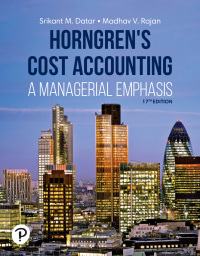Kappa Electricals, a producer of energy-efficient compact fluorescent lamps (CFLs), expects that demand will increase markedly over
Question:
Kappa Electricals, a producer of energy-efficient compact fluorescent lamps (CFLs), expects that demand will increase markedly over the next decade. Due to the high fixed costs involved in the business, Kappa has decided to evaluate its financial performance using absorption costing income. The production-volume variance is written off to cost of goods sold. The variable cost of production is $3 per CFL. Fixed manufacturing costs are $1,200,000 per year. Variable and fixed selling and administrative expenses are $0.25 per CFL sold and $250,000, respectively. Because its CFLs are currently popular with environmentally conscious customers, Kappa can sell the CFLs for $10 each.
Kappa is deciding among various concepts of capacity for calculating the cost of each unit produced. Its choices are as follows:

Required
1. Calculate the inventoriable cost per unit using each level of capacity to compute fixed manufacturing cost per unit.
2. Suppose Kappa actually produces 350,000 CFLs. Calculate the production-volume variance using each level of capacity to compute the fixed manufacturing overhead allocation rate.
3. Assume Kappa has no beginning inventory. If this year’s actual sales are 275,000 CFLs, calculate operating income for Kappa using each type of capacity to compute fixed manufacturing cost per unit.)
Step by Step Answer:

Horngrens Cost Accounting A Managerial Emphasis
ISBN: 9780135628478
17th Edition
Authors: Srikant M. Datar, Madhav V. Rajan





